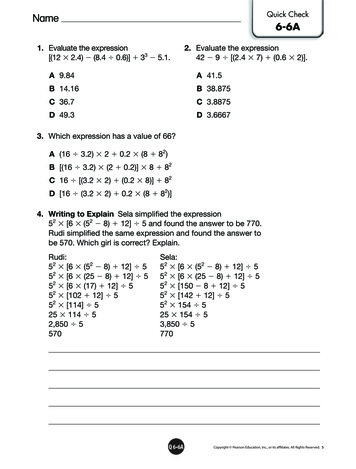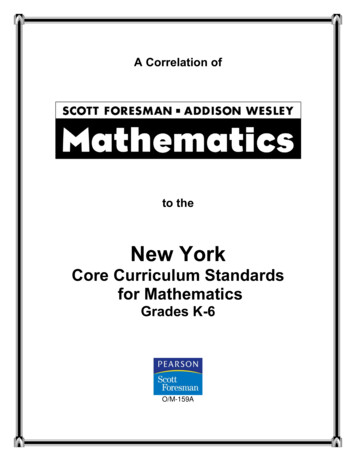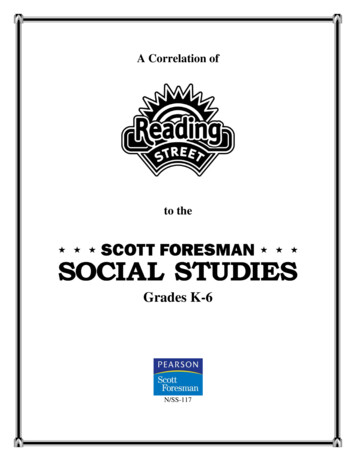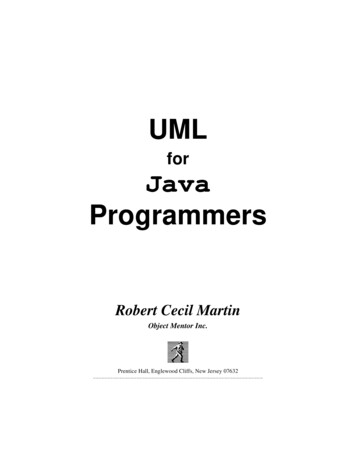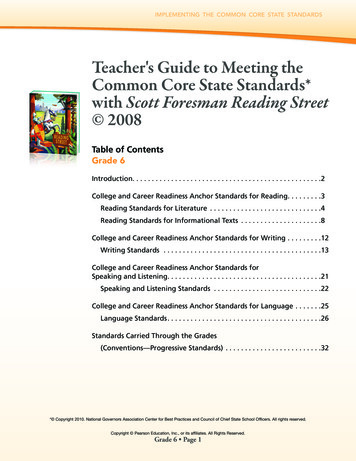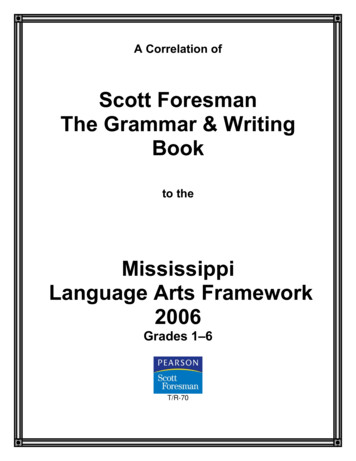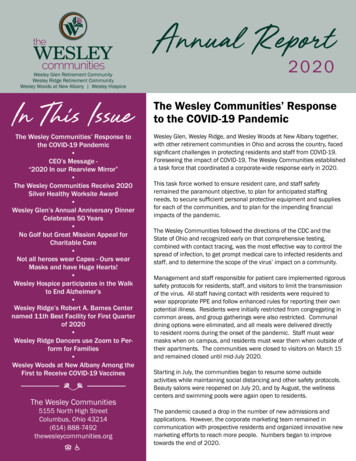
Transcription
Scope and SequenceGrades Pre-K–8SCOTT FORESMAN ADDISON WESLEYPRENTICE HALL
Scope and SequenceFor Scott Foresman - Addison Wesley Mathematicsand Prentice Hall MathematicsGrade KGrade Pre–KGrade 3Grade 1Grade 4Grade 6Grade 2Grade 5Grade 7Grade 6Grade 86-12 Version Also AvailableOur scope and sequence across Grades Pre-K–8 is carefully developed to guaranteefull coverage of important concepts and skills with no gaps to impede understanding.The curriculum outlined here reflects a sound instructional design based on scientificmathematics research and years of leadership in publishing mathematics materials.See PHSchool.com/math to obtain the Grade 6-12 Scope and Sequence.
Scott Foresman - Addison Wesley MathematicsGrade Pre-KGrade KGrade 1Grade 2Unit 1Counting and NumberChapter 1Position and SortingUnit 2Understanding ArithmeticOperations (Part 1)Chapter 2Graphing and PatternsChapter 1Patterns and Readiness forAddition and SubtractionChapter 1Understanding Additionand SubtractionChapter 2Understanding Additionand SubtractionChapter 2Fact Strategies for Additionand SubtractionChapter 3Strategies for Addition Factsto 12Chapter 3Place Value to 100 and MoneyUnit 3Spatial Sense and GeometryUnit 4PatternsUnit 5Understanding ArithmeticOperations (Part 2)Unit 6Measurement and DataUnit 7Logical ReasoningChapter 3Numbers Through 5Chapter 4Numbers Through 10Chapter 5Numbers Through 31Chapter 6MeasurementChapter 7Time and MoneyChapter 8Geometry and FractionsChapter 9Readiness for Additionand SubtractionChapter 10Understanding AdditionChapter 11Understanding SubtractionChapter 12Counting and NumberPatterns to 100Chapter 4Strategies for SubtractionFacts to 12Chapter 5Geometry and FractionsChapter 6TimeChapter 7Counting to 100Chapter 8Place Value, Data, and GraphsChapter 9MoneyChapter 10Measurement and ProbabilityChapter 11Addition and Subtraction Factsto 18Chapter 12Two-Digit Addition andSubtraction2Chapter 4Mental Math: Additionand SubtractionChapter 5Two-Digit AdditionChapter 6Two-Digit SubtractionChapter 7Geometry and FractionsChapter 8Time, Data, and GraphsChapter 9Measurement and ProbabilityChapter 10Numbers to 1,000Chapter 11Addition and Subtraction ofThree-Digit NumbersChapter 12Understanding Multiplicationand Division
Grade 3Grade 4Grade 5Grade 6Chapter 1Place Value and MoneyChapter 1Place Value and MoneyChapter 2Addition and SubtractionNumber SenseChapter 2Adding and Subtracting WholeNumbers and MoneyChapter 1Place Value, Adding,and SubtractingChapter 1Numbers, Expressions,and EquationsChapter 2DecimalsChapter 3Adding and SubtractingChapter 3Multiplication and DivisionConcepts and FactsChapter 2Multiplying Whole Numbersand DecimalsChapter 4Time, Data, and GraphsChapter 5Multiplication Conceptsand FactsChapter 6More Multiplication FactsChapter 7Division Concepts and FactsChapter 8Geometry and MeasurementChapter 9Fractions and MeasurementChapter 10Decimals and MeasurementChapter 11Multiplying and DividingGreater NumbersChapter 12Measurement and ProbabilityChapter 3Dividing with One-Digit DivisorsChapter 4Time, Data, and GraphsChapter 4Dividing with Two-Digit DivisorsChapter 5Multiplying by One-DigitNumbersChapter 5Data, Graphs, and ProbabilityChapter 6Multiplying by Two-DigitNumbersChapter 7DividingChapter 8Geometry and MeasurementChapter 9Fraction ConceptsChapter 10Fraction Operations andCustomary MeasurementChapter 11Decimals and MetricMeasurementChapter 12Graphing and ProbabilityChapter 6GeometryChapter 7Fraction ConceptsChapter 8Fraction OperationsChapter 9MeasurementChapter 10Measuring SolidsChapter 11Ratio, Proportion, and PercentChapter 12Algebra: Integers, Equations,and GraphingChapter 3Number Theory and FractionConceptsChapter 4Adding and SubtractingFractionsChapter 5Multiplying and DividingFractionsChapter 6Ratio, Rates, and ProportionChapter 7PercentChapter 8Algebra: Integers and RationalNumbersChapter 9GeometryChapter 10MeasurementChapter 11Data, Graphs, and ProbabilityChapter 12Algebra: Inequalities, Equations,and Graphs3
Prentice Hall MathematicsGrades 6–8Course 1Course 2Course 3Chapter 1Whole Numbers and DecimalsChapter 1Decimals and IntegersChapter 2Data and GraphsChapter 2Exponents, Factors, and FractionsChapter 1Integers and AlgebraicExpressionsChapter 3Patterns and VariablesChapter 3Operations with FractionsChapter 4Number Theory and FractionsChapter 4Equations and InequalitiesChapter 5Adding and SubtractingFractionsChapter 5Ratios, Rates, and ProportionsChapter 6Multiplying and DividingFractionsChapter 7Ratios, Proportions, andPercentsChapter 8Tools of GeometryChapter 9Geometry and MeasurementChapter 10IntegersChapter 11Exploring ProbabilityChapter 12Equations and Inequalities4Chapter 6PercentsChapter 7GeometryChapter 8MeasurementChapter 9Algebra: Patterns and RulesChapter 10Graphing in the Coordinate PlaneChapter 11Displaying and Analyzing DataChapter 12Using ProbabilityChapter 2Rational NumbersChapter 3Real Numbers and theCoordinate PlaneChapter 4Applications of ProportionsChapter 5Applications of PercentChapter 6Equations and InequalitiesChapter 7GeometryChapter 8MeasurementChapter 9Using Graphs to Analyze DataChapter 10ProbabilityChapter 11Algebra: FunctionsChapter 12Polynomials and Propertiesof Exponents
Scope and SequenceNumbersGrade56 NumerationPre-KK123One-to-one correspondence Relating sets of objects to numerals Using ordinal numbers for position Course4123 Counting, reading, writing, renamingNumbers to 10Numbers to 100Numbers to 1,000Numbers to 10,000Numbers to 1 million(through 999,999) Numbers to 1 billion (through 999,999,999)Greater numbersConcrete/pictorial and number-line models Comparing and ordering Place value Place-value relationships and patterns Forms of numbers (standard form, words, expanded form)Skip countingRounding Powers and exponentsNegative exponents Square numbers Scientific notation Number Theory Prime factorization Factor trees Even and odd numbers Prime and composite numbers Divisibility Early Experiences Introduce Develop Maintain and Apply5
GradeNumber Theory3456123 (GCF) Least common multiple (LCM) (cont’d)Pre-KK12CourseFactors and multiplesGreatest common factorMoneyCounting and showing amountsPenny, nickel, dime Quarter, half dollar, dollar Fives, tens, twenties Combinations of coins and bills Comparing amounts Making changeRounding to nearest dollarFraction Concepts(also see Number Theory)Concrete/pictorial models for partof a whole/part of a setReading and writing fractions Rounding/estimatingEquivalent fractionsLowest terms/simplest formMixed numbers, fractions greater than 1 Fractions on a number line Comparing and ordering Common denominatorsReciprocals Pictorial models Tenths and hundredths Related to decimalsRelated to percentsDecimal ConceptsMeaning Decimal notation for money Early Experiences6 Introduce Develop Maintain and Apply
CourseGradeDecimal Concepts(cont’d)Pre-KK1234Thousandths5612 Millionths Equivalent decimalsFractions as decimalsRelated to measurement(metric system)Decimals on a number line3Decimals and calculators Comparing and ordering Rounding Related to percent Terminating and repeating decimalsNon-repeating/irrational numbersScientific notationIntegers and Other NumbersIntegersMeaning Opposites Absolute valueComparing/ordering Applications of integers On a number line Ordered pairs in four quadrants Rational numbers Squares and square rootsComparing rational and irrational numbers Real numbers OperationsEstimation and Mental-Math StrategiesDeciding when to estimateUnderestimates and overestimates 7
GradeK12456123 Estimation and Mental-Math Strategies (cont’d) Pre-K3 Using a rangeAdjusting an estimateCourseUsing front-end digits Rounding whole numbers and decimals Rounding fractions and mixed numbers Substituting compatible numbers Using a reference point or benchmark ClusteringEstimating quantities and measures Counting on or back Breaking apart numbersCompensation Using 10s or 100s to add or subtract Using multiplication and division patternsUsing the distributive propertyDetermining reasonableness of results Whole-Number Addition Fact families Properties Meanings of addition Related to subtraction Basic facts and fact strategiesUsing concrete/pictorial models Adding 2-digit numbersAdding numbers up to 3 digitsAdding numbers with 4 or more digits Adding moneyThree or more addends Choosing a computation method Addition expressions/sentences/equations Estimation and mental mathProblem solving Early Experiences8 Introduce Develop Maintain and Apply
CourseGradeMeanings of subtractionPre-KK1234561 Whole-Number Subtraction Related to addition Basic facts and fact strategiesPropertiesUsing concrete/pictorial models Subtracting 2-digit numbers Subtracting 100s Subtracting 3-digit numbersSubtracting 4-digit numbers 3 Meanings of multiplication Related to addition Basic facts and fact strategies Fact families Multiplication stories Multiplication table Subtracting money 2Choosing a computation method Subtraction expressions/sentences/equations Inverse operationsEstimation and mental math Problem solving Whole-Number Multiplication(fact table)Three factorsProperties Using concrete/pictorial models By a 1-digit number Multiplying money By multiples of 10 and 100 Partial products By a multi-digit number Missing factors Exponents in multiplicationChoosing a computation method 9
GradeWhole-Number Multiplication23456123 Inverse operations Estimation and mental math Related to subtraction and multiplication Basic facts: 2, 3, 4, 5, 6, 7, 8, and 9 as divisors Fact families 2-digit dividends By a 1-digit divisor Dividing money By multiples of 10 and 100 By a 2-digit divisor Adding and subtracting, like denominators Adding and subtracting, unlike denominators (cont’d)Pre-KK1CourseMultiplication expressions/sentences/equationsProblem solvingWhole-Number DivisionMeanings of divisionDivision stories 1 and 0 in divisionUsing concrete/pictorial models By a multi-digit divisorAverage(mean) Interpreting remaindersChoosing a computation method Division expressions/sentences/equationsEstimation and mental mathProblem solving Fraction OperationsAdding and subtracting, pictorial modelsAdding and subtracting mixed numbersFinding a fraction of a whole number Multiplying and dividing fractions using models Early Experiences10 Introduce Develop Maintain and Apply
CourseGradeFraction Operations56123Multiplying fractions Multiplying mixed numbers Dividing whole numbers by fractions using models Dividing whole numbers by fractions Dividing fractions Dividing mixed numbers (cont’d)Pre-KK1234 Choosing a computation method Checking for reasonableness of results Expressions/sentences/equations Estimation and mental mathProblem solving Decimal OperationsAdding and subtracting money Multiplying and dividing money Multiplying a decimal by a decimal Dividing a decimal by a whole number Adding and subtracting with pictorial modelsAdding and subtracting Multiplying by a whole numberMultiplying by a power of 10 Multiplying and dividing with pictorial modelsDividing a decimal by a decimal Adding and subtracting integers Using a pictorial or number-line model Expressions/sentences/equations Estimation and mental mathProblem solving Integer OperationsMultiplying and dividing integersExpressions/sentences/equations 11
GradeInteger Operations6123 Defining ratio Reading and writing ratios Equivalent ratios in tables, graphs Rates and unit prices Solving proportions Distance, rate, time Reasoning with proportions Related to maps and scale drawings Related to similar figures (cont’d)Pre-KK123Course45Estimation and mental mathProblem solvingRatio, Proportion, and PercentRatio and ProportionRelated to scale modelsEstimation and mental math PercentMeaning of percent Reading and writing Related to fractions and decimals Using percent modelsComparing and ordering fractions, decimals,and percents Finding a percent of a numberGreater than 100%, less than 1% Finding what percent one number is of anotherFinding a number when a percent is known Using equations with percent Using proportions with percent Discount, sales tax, tipping Interest, commission Related to circle graphs Early Experiences12 Introduce Develop Maintain and Apply
CourseGradePercentPre-K(cont’d)K1234Estimation and mental math56123 Identifying polygons Sides and corners/vertices Identifying solid figures Percent increase and decreaseGeometryPlane and Solid FiguresPoints, lines, line segments, rays, anglesMeasuring anglesSum of the interior angles of a polygonCircles, parts of Faces, edges, vertices Combining shapes Subdividing shapesSymmetry Relating plane and solid figures Rotational symmetry Identifying and drawing patterns for solids (nets) TessellationsDrawing figures from descriptions Drawing/constructing/building Making conjectures about geometric relationships Pythagorean Theorem Visual thinkingReflections, translations, rotations oncoordinate grids Enlargements, reductions, dilationsTrigonometric ratios(sine, cosine, tangent)Geometric models for real-world situations Geometric figures on coordinate systemClassifying FiguresCongruent figuresCongruent angles 13
GradeClassifying FiguresTransformations(cont’d)(slides, flips, turns)CoursePre-KK1234561 Similar figures23 Pairs of lines/line segments(parallel, perpendicular, skew) Triangles Quadrilaterals Angles, compared to right anglePolygons Polyhedrons/solid shapes MeasurementLength, Weight/Mass, Capacity,and TemperatureComparing and ordering using direct comparison Nonstandard units Length: fraction of an inch Length: yards Customary unitsLength: inches, feetLength: milesCapacity: fluid ounces, teaspoons,tablespoonsCapacity: cups Capacity: pints, quarts Capacity: gallons Weight: ounces Weight: pounds Weight: tonsTemperature: degrees Fahrenheit Metric unitsLength: millimeters Early Experiences14 Introduce Develop Maintain and Apply
CourseGradeLength, Weight/Mass, Capacity,and Temperature (cont’d)Pre-KKLength: centimeters123456123 Length: metersLength: decimeters, kilometersLength: dekameters, hectometers Capacity: liters Capacity: milliliters Capacity: kilolitersMass: grams Mass: kilograms Temperature: degrees Celsius Length, estimating using benchmarks Capacity, estimating using benchmarks Weight/mass, estimating using benchmarks Choosing appropriate measuring units Choosing appropriate measuring instruments CompassGraph paperProtractorRuler TimeNearest hour/half hour Minutes before/after the hourReading schedules Elapsed time Calendar Estimating timeRelationships between units of timeA.M. and P.M. 15
GradePerimeter, Area, and VolumePre-KKCourse23 Area of a parallelogram Area of a triangle Area of a trapezoid Perimeter, estimating and counting units1234561 Perimeter formulasCircumferenceArea, estimating and counting square units Area of a rectangleArea of a circleArea of composite figures Surface area of a prismSurface area of a cylinder Volume formulas Volume of a prism Volume, estimating and counting cubic units Volume of a cylinder Volume of cone/pyramid/sphere Length/perimeter/area relationships Length/perimeter/area/volume relationships Irregular figures Estimate by attribute: dimensional analysisChoosing appropriate type of unit:length, area, volume Converting UnitsLength, converting units Capacity, converting units Weight/mass, converting units Converting units between systems Adding and subtracting measures Connecting volume, mass, and capacity Precision and error in measurement Significant digits Early Experiences16 Introduce Develop Maintain and Apply
Data Analysis and ProbabilityGraphsCourseGradePre-KK123456123 Reading and making graphsPictographs/real graphsBar graphsDouble bar graphs Stacked/sliding bar graphs Line graphs Multiple line graphs Circle graphs Stem-and-leaf plots Box-and-whisker plots Histograms Scatterplots Misleading graphs Naming ordered pairs Graphing ordered pairsGraphing equations Line plots Identifying trend line and line of best fitChoosing appropriate graphs Making predictions from graphs Making charts/tables Tally charts Taking a survey Drawing and comparing different representationsData Collection and AnalysisWriting a survey Collecting and organizing data Reading charts/tables Identifying bias in surveysInterpreting dataMaking predictions, interpolations, extrapolationsSampling techniques 17
GradeData Collection and Analysis(cont’d)Pre-KK123Course456123 Mean/mode/range Median Describing sets of data Frequency distribution Outliers and quartiles Determining trends from data Comparing related sets of data Misleading statisticsUsing data in problem solving ProbabilityProbability experimentsConducting simulations Tree diagrams Writing probability as a fraction Compound events Complementary events Fundamental counting principle Permutations and combinations Outcomes Writing probability as a decimal or percentCertain/possible/impossible events Experimental/theoretical probabilityIndependent and dependent eventsMaking predictions Estimating probability of simple andcompound events Fair and unfair games Early Experiences18 Introduce Develop Maintain and Apply
AlgebraCourseGradePatterns, Properties, and ExpressionsPre-KK123456123 Making generalizations and predictions Patterns using words, tables, and graphs In tables, charts, and graphs Used to make predictions Patterns with objects/geometric figuresNumber patterns Skip countingSequencesArithmetic and geometric Fibonacci sequence Logical reasoning Venn diagrams Addition propertiesCommutative and associative properties Adding zero Opposites(identity property)(additive inverse property)Multiplication properties Associative property Multiplying by 1 (identity property) Multiplying by 0 Reciprocals(zero property) Commutative property (multiplicative inverse property)Distributive propertyWriting/evaluating numerical expressions Order of operations Expressions with parenthesesExpressions with exponentsWriting/evaluating expressions with variables Writing inequalitiesSimplifying expressions with variables 19
GradePatterns, Properties, and Expressions (cont’d) Pre-KK123Course456123 Explaining properties and relationships Integers (see Numbers: Integers and other Numbers) Applying properties to expressions with variablesRelationships Sorting and classifying Function tables (input/output tables) Function tables, rules stated using variablesGraphing functions Using symbols to show relationships Relating addition and subtraction Relating multiplication and division Ordered pairs Finding rate of change and slope Identifying linear functions Analyzing and interpreting linear relationships Making generalizations about linear relationships Identifying quadratic functions Identifying other nonlinear functions Modeling problem situations with objects Equations and Inequalities Finding missing factors Equations that use letters as variables Expressing relationships using equations Completing number sentencesFinding missing addends, subtrahends, minuends Solving equations using tables, graphs, and modelsEquations with decimals, fractions, integersSolving equations by substitution Solving one-step equations Solving two-step equations Early Experiences20 Introduce Develop Maintain and Apply
CourseGradeEquations and Inequalities (cont’d)Pre-KK123456123 Solving multi-step equations Identifying slope and intercepts Graphing equations using slope and intercepts Graphing linear equations Solving systems of linear equationsNon-linear relationsInequalities Using inequality symbols to compare numbers Solving one-step inequalitiesSolving two-step inequalitiesSolving problems using formulas Formulas Properties of equality and inequality Solving problems using equations and inequalitiesMathematical ProcessesProblem-Solving SkillsUsing a problem-solving planUse data from a picture, graph, table Choose an operation Multiple-step problems Extra or missing information Exact answer or estimate Writing to explain Writing to describe Writing to compare Interpreting remainders Translating words to expressionsWriting to persuadeUsing a calculator or computer 21
GradeProblem-Solving StrategiesCoursePre-KK123456123 Draw a picture Use logical reasoning Try, check, and revise Make an organized list Make a table Make a graph Solve a simpler problem Work backward Act it out, use objects, do simulationsLook for a pattern Write a number sentence/equation/proportion Choose a strategyCompare strategiesUsing multiple strategies Reasoning and ProofLogical reasoningComparing/contrasting Classifying/sorting/Venn diagrams Finding/extending/using patterns Making connections Making/testing conjectures Explaining/justifying answers/checkingfor reasonableness Making generalizations Drawing conclusions and evaluating argumentsVisual and creative thinkingVisual patterns/spatial reasoningSolving non-routine problemsGenerating problems Early Experiences22 Introduce Develop Maintain and Apply
CourseGradeConnectionsPre-KK123456123 Consumer Career Curriculum connections to other subjectsConnections among mathematical ideasReal-world connectionsStudents’ daily lives Writing to explain Writing to compare Writing to describe Multicultural connectionsConnections using technologyCommunicationWriting to persuadeReading for math success/reading assists/math language Write about it/journal Talk about it/share Working in groups Writing convincing arguments usingmathematical ideasRepresentationConcrete/pictorial and number-line models forwhole numbers Integers on a number lineWhole-number addition/subtraction usingconcrete/pictorial modelsWhole-number multiplication/division usingconcrete/pictorial models 23
GradeRepresentation (cont’d)Pre-KK123Course4Integer computation using pictorial ornumber-line modelsConcrete/pictorial models for part ofa whole/set 56123 Fractions on a number line Fraction operations using pictorial models Integers on a number line Integer operations using pictorial ornumber-line models Ratio, proportion, percent models Proportions related to maps and scale drawings Dividing whole numbers by fractions usingpictorial models Pictorial models for decimalsDecimals on a number line Decimal operations using pictorial modelsCounting units to find length, area, volume Geometric models for real-world situations Making graphs/charts/tables/diagramsModels for equations (algebra tiles, two-color counters)Solving problems by drawing a picture/diagram Number sentences and equations to modelreal situations Early Experiences24 Introduce Develop Maintain and Apply
Grade Pre-KGrade KGrade 3Grade 1Grade 4Grade 6Grade 2Grade 5Grade 70-13-350163-9Grade 6Grade 83M.V1.1106.AV.JC.RG
SCOTT FORESMAN ADDISON WESLEY PRENTICE HALL. . Grade 4 Grade 5 Grade 6 Grade K Grade 1 Grade 2. Grade Pre-K Unit 1 Counting and Number Unit 2 Understanding Arithmetic Operations (Part 1) . Chapter 4 Mental Math: Addition and Subtraction Chapter 5 Two-Digit Addition Chapter 6 Two-Digit Subtraction
